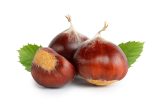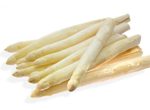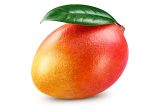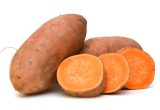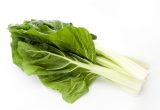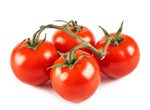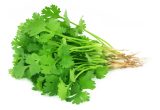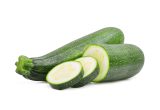Soybean sprouts

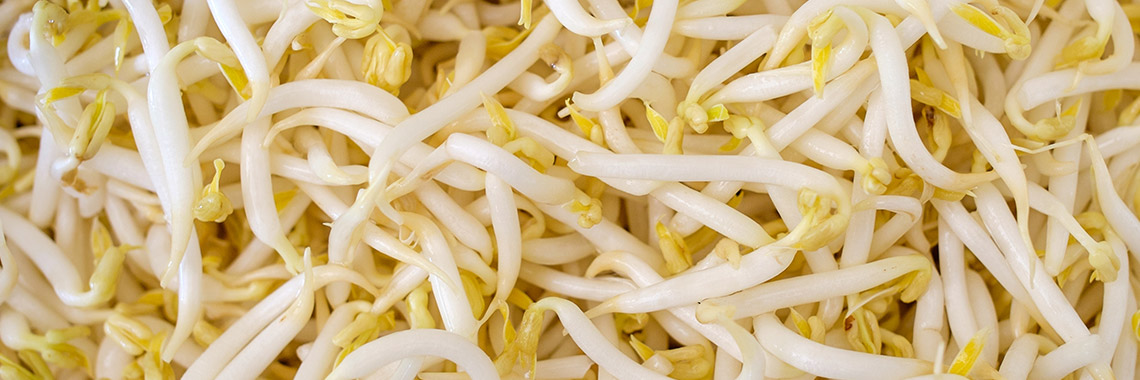
Description
- Soybean sprouts are actually shoots or sprouts of mung bean (Heuzé, 2015). The mung bean (Vigna radiata L.) is a member of the Fabaceae family (INPN, 1954).
- It is native to India (Akpapunam, 1996) and, today, widely cultivated in Asia (Heuzé, 2015).
- Soybean sprouts are produced by germinating mung bean seeds in a controlled environment at high temperature (22-24°C) and humidity (75±5%) for 5 days (Lacumin, 2019).
- Thanks to their low price and health benefits, bean sprouts are among the most consumed shoots in the world and especially in Asian countries (Heuzé, 2015; Ebert, 2017).
PHYSICAL AND ORGANOLEPTIC CHARACTERISTICS
- Soybean sprouts are long: they measure between 7 and 9 cm for the stem and between 3 and 4 cm for the roots (Zhang, 2018).
- Fresh shoots are quite firm (Bari, 2005) with a slightly sweet and nutty taste (NaJom, 2012)
- Their colour is white (NaJom, 2012).
- They do not keep well and should be eaten quickly (1 or 2 days). When stored at room temperature, the shoots continue to grow and expire. Signs of expiration are: browning of roots and cotyledons, dark spots on the stem, thinning, development of a musty odour and decrease in acidity. Low temperature storage extends the shelf life to 5 days (Bari, 2005; Goyal, 2014).
- Hexanol, benzyl alcohol, ϒ-butyrolactone, 2-methyl-2-propenal and pentanol have been identified as the main components responsible for the aroma of soybean sprouts (Lee, 2000).
COMPOSITION CHARACTERISTICS (excluding macronutrients, vitamins and minerals)
- Soybean sprouts contain free polyphenols including flavonoids and phenolic acids. Flavonoids include quercetin, kaempferol, luteolin and apigenin (Pajak, 2014), but also vitexin, isovitexin, rutin, isoquercetin, genistein, daidzein and iosrhamnetin (Tang, 2014a). Among the phenolic acids, gallic acid, caffeic acid, ρ-coumaric acid, ferulic acid, chlorogenic acid and sinapic acid are found. Some of these compounds are also found in more complex forms bound to cell walls (Pajak, 2014).
- The content of phenolic acids and flavonoids increases with the germination time (Guo, 2012).
- Soybean sprouts contain very few carotenoids. Among those analysed, lutein was the most abundant (from 0.15 to 0.19 mg/100 g). As for α and β-carotene, they had low levels (0.01 mg/100 g and between 0.053 and 0.073 mg/100 g, respectively) (Ebert, 2017).
- Polyphenols impart antioxidant activity to soybean sprout (Guo, 2012; Pajak, 2014). They are known to have anti-inflammatory (Yahfoufi, 2018), anti-cancer (Hou, 2019) and antiseptic effects (Tang, 2014b).
- An enzyme (chitinase) and some peptides (nsLTP, mungin) isolated from soybean sprouts show antimicrobial effect (Tang, 2014b).
- Vitexin and isovitexin show hypolipidemic and hypoglycemic effects (Hou, 2019).
RAW
The following values are approximate and depend on variety, season, ripeness, cultivation conditions, etc. Raw soybean sprouts are low in energy*. On average, they provide 29.50 calories (kcal) per 100 g, i.e. 124 kJ.
COMPOSITION TABLES
For each nutrient, the tables provide information on the content, minimum and maximum values, as well as the percentage of the Dietary Reference Values (DRVs) for 100 g net of raw soybean sprouts, also known as mung bean sprouts.
*Regulation (EC) No 1924/2006 of the European Parliament and of the Council of 20 December 2006 on nutrition and health claims made on foods.
MACRONUTRIENTS
| Constituent (g) | Average content |
Min-Max per 100g |
DRV% |
|---|---|---|---|
| Water | 91,70 | 69,10 - 95,80 | - |
| Fibers | 1,70 | 0,80 - 1,80 | - |
| Carbohydrates | 3,40 | NC - 4,50 | 1,31 |
| Sugars | 3,40 | NC - 4,13 | 3,78 |
| Lipids | < 0,50 | 0 - 6,70 | - |
| Saturated fat | < 0,0002 | NC - 0,93 | - |
| Protein | 2,57 | 1,71 - 13,10 | 5,14 |
| Constituent (g) | Amount | Min-Max | DRV% |
|---|---|---|---|
| Water | Ciqual 2020 | - | - |
| Fibers | Ciqual 2020 | - | - |
| Carbohydrates | Ciqual 2020 | - | Règlement (UE) N°1169/2011 du parlement Européen, et du conseil du 25 octobre 2011 |
| Sugars | Ciqual 2020 | - | Règlement (UE) N°1169/2011 du parlement Européen, et du conseil du 25 octobre 2011 |
| Lipids | Ciqual 2020 | - | Règlement (UE) N°1169/2011 du parlement Européen, et du conseil du 25 octobre 2011 |
| Saturated fat | Ciqual 2020 | - | Règlement (UE) N°1169/2011 du parlement Européen, et du conseil du 25 octobre 2011 |
| Protein | Ciqual 2020 | - | Règlement (UE) N°1169/2011 du parlement Européen, et du conseil du 25 octobre 2011 |
Zoom on carbohydrates
- Raw soybean sprouts contain less carbohydrates (3.40 g per 100 g) than the average carbohydrate content of raw vegetables: about 4.45 g per 100 g.
- Soybean sprouts are low in sugar* as they contain less than 5 g of sugars per 100 g (3.40 g per 100 g).
Zoom on fibres
- Raw soybean sprouts provide 1.70 g of fibre per 100 g.
- This amount is below the average quantity found in raw vegetables (2.43 g per 100 g).
Zoom on proteins
- Their protein content (2.57 g per 100 g) is higher than the average amount found in raw vegetables (1.87 g per 100 g).
Zoom on lipids
- With a fat content of less than 0.5 g per 100 g, raw soybean sprouts are therefore fat-free*.
*Regulation (EC) No 1924/2006 of the European Parliament and of the Council of 20 December 2006 on nutrition and health claims made on foods.
MINERALS AND TRACE ELEMENTS
| Constituent | Average content |
Min-Max per 100g |
DRV% |
|---|---|---|---|
| Calcium (mg) | 16 | 13 - 67 | 2 |
| Chloride (mg) | 6,70 | - | 0,84 |
| Copper (mg) | 0,10 | 0,09 - 0,43 | 10 |
| Iron (mg) | 0,44 | NC - 2,10 | 3,14 |
| Iodine (µg) | < 20 | - | - |
| Magnesium (mg) | 16 | 10 - 72 | 4,27 |
| Manganese (mg) | 0,12 | NC - 0,70 | 6 |
| Phosphorus (mg) | 43 | NC - 164 | 6,14 |
| Potassium (mg) | 120 | 36 - 484 | 6 |
| Selenium (µg) | < 50 | - | - |
| Sodium (mg) | 17,10 | 6 - 30 | - |
| Zinc (mg) | 0,32 | NC - 1,17 | 3,20 |
| Constituent | Amount | Min-Max | DRV% |
|---|---|---|---|
| Calcium (mg) | Ciqual 2020 | - | Règlement (UE) N°1169/2011 du parlement Européen, et du conseil du 25 octobre 2011 |
| Chloride (mg) | Ciqual 2020 | - | Règlement (UE) N°1169/2011 du parlement Européen, et du conseil du 25 octobre 2011 |
| Copper (mg) | Ciqual 2020 | - | Règlement (UE) N°1169/2011 du parlement Européen, et du conseil du 25 octobre 2011 |
| Iron (mg) | Ciqual 2020 | - | Règlement (UE) N°1169/2011 du parlement Européen, et du conseil du 25 octobre 2011 |
| Iodine (µg) | Ciqual 2020 | - | Règlement (UE) N°1169/2011 du parlement Européen, et du conseil du 25 octobre 2011 |
| Magnesium (mg) | Ciqual 2020 | - | Règlement (UE) N°1169/2011 du parlement Européen, et du conseil du 25 octobre 2011 |
| Manganese (mg) | Ciqual 2020 | - | Règlement (UE) N°1169/2011 du parlement Européen, et du conseil du 25 octobre 2011 |
| Phosphorus (mg) | Ciqual 2020 | - | Règlement (UE) N°1169/2011 du parlement Européen, et du conseil du 25 octobre 2011 |
| Potassium (mg) | Ciqual 2020 | - | Règlement (UE) N°1169/2011 du parlement Européen, et du conseil du 25 octobre 2011 |
| Selenium (µg) | Ciqual 2020 | - | Règlement (UE) N°1169/2011 du parlement Européen, et du conseil du 25 octobre 2011 |
| Sodium (mg) | Ciqual 2020 | - | - |
| Zinc (mg) | Ciqual 2020 | - | Règlement (UE) N°1169/2011 du parlement Européen, et du conseil du 25 octobre 2011 |
Zoom on minerals and trace elements
- Raw soybean sprouts provide a significant amount of copper: 0.10 mg per 100 g, equivalent to 10% of DRVs.
- The amount of other minerals and trace elements is less than 7% of DRVs.
VITAMINS
| Constituent | Average content |
Min-Max per 100g |
DRV% |
|---|---|---|---|
| Provitamin A Beta-carotene (µg) | < 10 | 0 - NC | - |
| Vitamin A equivalent (µg) | < 1,67 | 0 - NC | - |
| Vitamin B1 (mg) | 0,065 | NC - 0,34 | 5,91 |
| Vitamin B2 (mg) | 0,06 | NC - 0,12 | 4,29 |
| Vitamin B3 (mg) | 0,71 | NC - 1,15 | 4,44 |
| Vitamin B5 (mg) | 0,17 | 0 - 0,93 | 2,83 |
| Vitamin B6 (mg) | 0,06 | 0,03 - 0,18 | 4,29 |
| Vitamin B9 (µg) | 61,30 | 61 - 172 | 30,65 |
| Vitamin C (mg) | 4,13 | NC - 15,30 | 5,16 |
| Vitamin E (mg) | 0,095 | 0,09 - 0,10 | 0,79 |
| Vitamin K1 (µg) | 2,10 | NC - 33 | 2,80 |
| Constituent | Amount | Min-Max | DRV% |
|---|---|---|---|
| Provitamin A Beta-carotene (µg) | Ciqual 2020 | - | - |
| Vitamin A equivalent (µg) | Calcul à partir de la valeur Provitamine A Béta-carotène* | - | Règlement (UE) N°1169/2011 du parlement Européen, et du conseil du 25 octobre 2011 |
| Vitamin B1 (mg) | Ciqual 2020 | - | Règlement (UE) N°1169/2011 du parlement Européen, et du conseil du 25 octobre 2011 |
| Vitamin B2 (mg) | Ciqual 2020 | - | Règlement (UE) N°1169/2011 du parlement Européen, et du conseil du 25 octobre 2011 |
| Vitamin B3 (mg) | Ciqual 2020 | - | Règlement (UE) N°1169/2011 du parlement Européen, et du conseil du 25 octobre 2011 |
| Vitamin B5 (mg) | Ciqual 2020 | - | Règlement (UE) N°1169/2011 du parlement Européen, et du conseil du 25 octobre 2011 |
| Vitamin B6 (mg) | Ciqual 2020 | - | Règlement (UE) N°1169/2011 du parlement Européen, et du conseil du 25 octobre 2011 |
| Vitamin B9 (µg) | Ciqual 2020 | - | Règlement (UE) N°1169/2011 du parlement Européen, et du conseil du 25 octobre 2011 |
| Vitamin C (mg) | Ciqual 2020 | - | Règlement (UE) N°1169/2011 du parlement Européen, et du conseil du 25 octobre 2011 |
| Vitamin E (mg) | Ciqual 2020 | - | Règlement (UE) N°1169/2011 du parlement Européen, et du conseil du 25 octobre 2011 |
| Vitamin K1 (µg) | Ciqual 2020 | - | Règlement (UE) N°1169/2011 du parlement Européen, et du conseil du 25 octobre 2011 |
Zoom on vitamins
- Raw soybean sprouts are high in vitamin B9 as they provide the equivalent of 30.65% of DRVs, i.e. 61.30 µg per 100 g.
- The quantity of other vitamins represents less than 6% of DRVs.
*Calculation made: Beta Carotene / 6 + retinol
POLYPHENOLS
| Constituent (mg) | Average content |
Min-Max per 100mg |
|---|---|---|
| Flavonoids (mg) | 14,05 | 3,50 - 17,26 |
| of which Isoflavonoids (mg) | 14,05 | 3,50 - 17,26 |
| Phenolic Acids (mg) | 1,40 | 1,40 - 1,40 |
| of which Hydroxybenzoic acids (mg) | 0,81 | 0,81 - 0,81 |
| of which Hydroxycinnamic acids (mg) | 0,59 | 0,59 - 0,59 |
| Total polyphenols | 15,45 | 4,90 - 18,66 |
| Constituent (mg) | Amount | Min-Max |
|---|---|---|
| Flavonoids | Phénol-Explorer version 3.6 Méthode utilisée : Chromatographie | - |
| of which Isoflavonoids | Phénol-Explorer version 3.6 Méthode utilisée : Chromatographie | - |
| Phenolic Acids | Phénol-Explorer version 3.6 Méthode utilisée : Chromatographie | - |
| of which Hydroxybenzoic acids | Phénol-Explorer version 3.6 Méthode utilisée : Chromatographie | - |
| of which Hydroxycinnamic acids | Phénol-Explorer version 3.6 Méthode utilisée : Chromatographie | - |
| Total polyphenols | Phénol-Explorer version 3.6 Méthode utilisée : Chromatographie | - |
Zoom on polyphenols
- Polyphenols are substances with an antioxidant effect.
- Isoflonoids, a subgroup of flavonoids, are the main polyphenols present in raw soybean sprouts, representing 90.94% of the total polyphenols identified.
- Next come hydroxybenzoic acids and hydroxycinnamic acids (subgroups of phenolic acids) representing 5.24% and 3.82% of total polyphenols respectively.
Nutrition and health claims
According to the definitions of nutrition claims as set out in Regulation (EC) No 1924/2006 on nutrition and health claims, and in view of the composition of soybean sprouts, the following claims may be used:
NUTRITION BENEFITS OF RAW SOYBEAN SPROUTS
- Low in energy (100 g of raw soybean sprouts provide less than 40 kcal)
- Low in sugar (100 g of raw soybean sprouts contain less than 5 g of sugar)
- Fat-free (100 g of raw soybean sprouts contain less than 0.5 g of fat)
- High in vitamin B9 (100 g of raw soybean sprouts provide more than 30% of DRVs)
HEALTH CLAIMS (for a consumption of 100 g of raw soybean sprouts)
Folates or vitamin B9
- Folates contribute to:
- maternal tissue growth during pregnancy,
- normal amino acid synthesis,
- normal blood formation,
- normal homocysteine metabolism,
- normal psychological function,
- normal function of the immune system,
- reduction of tiredness and fatigue.
- Folates have a role in the process of cell division.
References
- Agence nationale de sécurité sanitaire de l’alimentation, de l’environnement et du travail. Table de composition nutritionnelle des aliments Ciqual 2020. Consultée le 14/09/2020 depuis le site internet Ciqual https://ciqual.anses.fr/
- Agence nationale de sécurité sanitaire de l’alimentation, de l’environnement et du travail. Table de composition nutritionnelle des aliments Ciqual pour le calcul des apports nutritionnels CALNUT 2020. Consultée le 14/09/2020 depuis le site internet Ciqual https://ciqual.anses.fr/
- Akpapunam M. (1996) Mung bean (Vigna radiata (L.) Wilczek). Food and Feed from Legumes and Oilseeds. Boston : Springer. 398p
- Bari ML, Nakauma M, Todoriki S, Juneja VK, Isshiki K, Kawamoto S. Effectiveness of irradiation treatments in inactivating Listeria monocytogenes on fresh vegetables at refrigeration temperature. J Food Prot. 2005;68(2):318-23.
- Ebert AW, Chang CH, Yan MR, Yang RY. Nutritional composition of mungbean and soybean sprouts compared to their adult growth stage. Food Chem. 2017;237:15-22.
- Goyal A, Siddiqui S. Effects of ultraviolet irradiation, pulsed electric field, hot water dip and ethanol vapours treatment on keeping and sensory quality of mung bean (Vigna radiata L. Wilczek) sprouts. J Food Sci Technol. 2014;51(10):2664-70
- Guo X, Li T, Tang K, Liu RH. Effect of germination on phytochemical profiles and antioxidant activity of mung bean sprouts (Vigna radiata). J Agric Food Chem. 2012;60(44):11050-5.
- Heuzé V, Tran G., Bastianelli D, Lebas F. Feedipedia, a programme by INRA, CIRAD, AFZ and FAO 2015. Mung bean (Vigna radiata) [en ligne]. [consulté le 21 avril 2020] Disponible à l’adresse : https://www.feedipedia.org/node/235
- Hou D, Yousaf L, Xue Y, Hu J, Wu J, Hu X, Feng N, Shen Q. Mung Bean (Vigna radiata L.): Bioactive Polyphenols, Polysaccharides, Peptides, and Health Benefits. Nutrients. 2019;11(6). pii: E1238.
- Lacumin L, Comi G. Microbial quality of raw and ready-to-eat mung bean sprouts produced in Italy. Food Microbiol. 2019;82:371-7.
- Inventaire National du Patrimoine Naturel (INPN). Vigna radiata (L.) Wilczek, 1954. [en ligne]. [consulté le 19 avril 2020]. Disponible à l’adresse : https://inpn.mnhn.fr/espece/cd_nom/630879/tab/taxo
- Lee, K.G., Shibamoto, T. Antioxidant properties of aroma compounds isolated from soybeans and mung beans. J. Agric. Food Chem. 2000;48(9): 4290-3
- Na Jom K. Metabolite profiling of sprouting mung beans (Vigna radiata). These de science. Munich : Université technique de Munich. 2012. 114p
- Neveu V, Perez-Jiménez J, Vos F, Crespy V, du Chaffaut L, Mennen L, Knox C, Eisner R, Cruz J, Wishart D, Scalbert A. (2010) Phenol-Explorer: an online comprehensive database on polyphenol contents in foods. Database, doi: 10.1093/database/bap024. Full text (free access)
- Pająk P, Socha R, Gałkowska D, Rożnowski J, Fortuna T. Phenolic profile and antioxidant activity in selected seeds and sprouts. Food Chem. 2014;143:300-6.
- Règlement (CE) N° 1924/2006 du Parlement européen et du Conseil du 20 décembre 2006 concernant les allégations nutritionnelles et de santé portant sur les denrées alimentaires.
- Règlement (UE) N°432/2012 de la Commission du 16 mai 2012 établissant une liste des allégations de santé autorisées portant sur les denrées alimentaires, autres que celles faisant référence à la réduction du risque de maladie ainsi qu’au développement et à la santé infantiles.
- Règlement (UE) n°1169/2011 du Parlement européen et du Conseil du 25 octobre 2011 concernant l’information des consommateurs sur les denrées alimentaires, modifiant les règlements (CE) n°1924/2006 et (CE) n°1925/2006 du Parlement européen et de Conseil et abrogeant la directive 87/250/CEE de la Commission, la directive 90/496/CEE du Conseil, la directive 1999/10/CE de la Commission, la directive 200/13/CE du Parlement européen et du Conseil, les directives 2002/67/CE et 2008/5/CE de la Commission et le règlement (CE) n°608/2004 de la Commission.
- Tang D, Dong Y, Guo N, Li L, Ren H. Metabolomic analysis of the polyphenols in germinating mung beans (Vigna radiata) seeds and sprouts. J Sci Food Agric. 2014a;94(8):1639-47.
- Tang D, Dong Y, Ren H, Li L, He C. A review of phytochemistry, metabolite changes, and medicinal uses of the common food mung bean and its sprouts (Vigna radiata). Chem Cent J. 2014b;8(1):4.
- Yahfoufi N, Alsadi N, Jambi M, Matar C. The Immunomodulatory and Anti-Inflammatory Role of Polyphenols. Nutrients. 2018;10(11). pii: E1618.
- Zhang M, Hu L, Wang H, Song Y, Liu Y, Li H, Shao M, Huang H, Kang Z. One-step hydrothermal synthesis of chiral carbon dots and their effects on mung bean plant growth. Nanoscale. 2018;10(26):12734-42.





